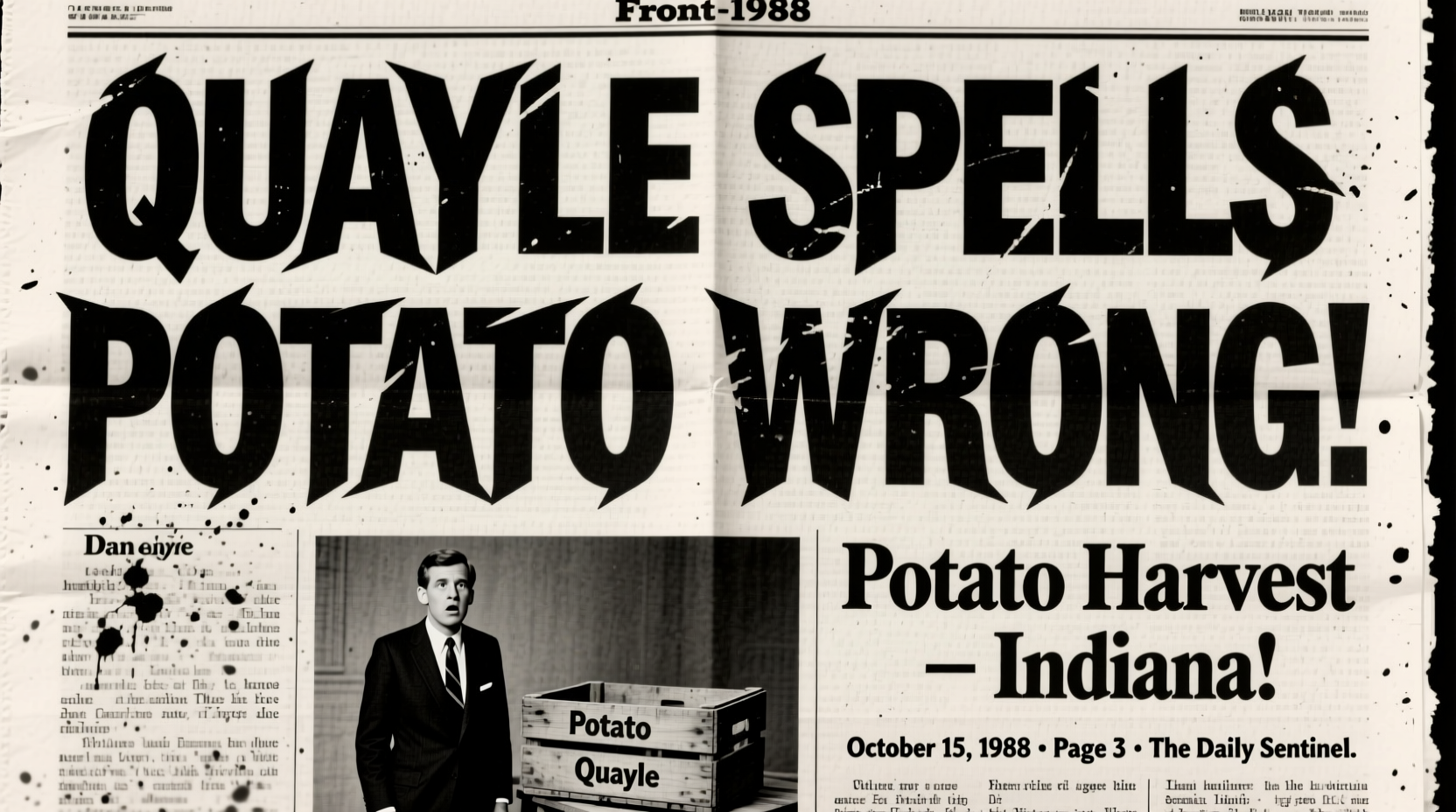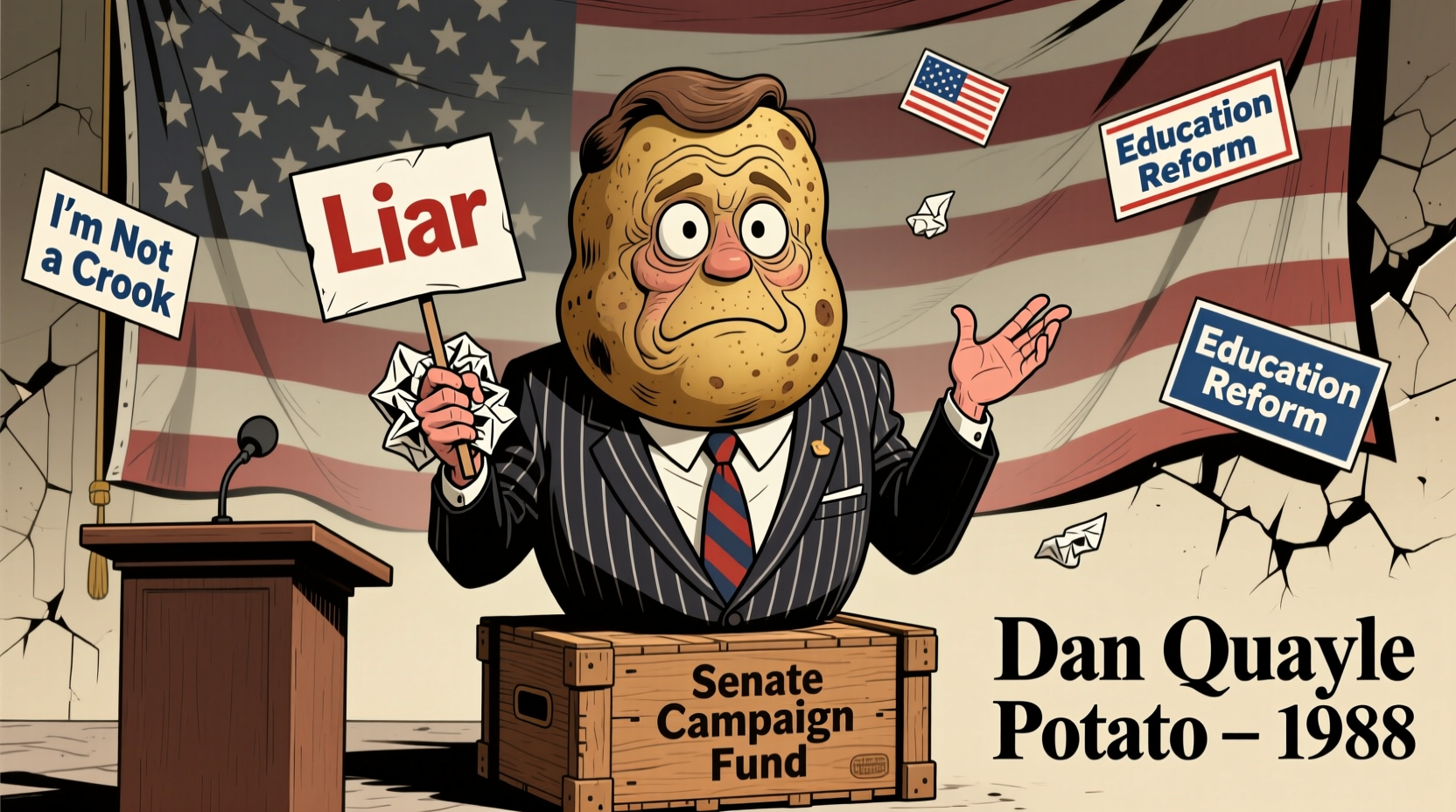The Dan Quayle Potato Incident: What Really Happened
On June 15, 1988, during a campaign stop in Trenton, New Jersey, Senator Dan Quayle, then the Republican nominee for Vice President, participated in a ceremonial sixth-grade spelling bee at the Eisenhower Middle School. The moment that would define his public image occurred when 12-year-old William Figueroa correctly spelled “potato” on his placard. Quayle, consulting a pre-arranged cue card provided by his staff, insisted the correct spelling was “potatoe” with an “e” at the end.
This seemingly minor error became a national sensation, transforming what should have been a routine campaign event into one of the most enduring political blunders in modern American history. The incident wasn't just about misspelling a common word – it became symbolic of perceptions about Quayle's preparedness for high office.
Timeline of the Infamous Spelling Bee
| Date | Event |
|---|---|
| June 15, 1988 | Quayle participates in Trenton middle school spelling bee |
| June 15, 1988 (immediately after) | National media begins reporting the “potatoe” incident |
| June 16, 1988 | Quayle's staff claims the error came from a pre-printed card |
| June 17-30, 1988 | Comedians and late-night hosts begin incorporating “potatoe” jokes |
| 1988-1992 | “Potatoe” becomes shorthand for political gaffes in American media |
| Present day | Incident remains one of the most referenced political blunders in history |
Why This Spelling Mistake Mattered So Much
The “potatoe” incident resonated far beyond a simple spelling error for several important reasons:
- Context of the campaign: Quayle was already facing questions about his readiness for the Vice Presidency at age 41, making any perceived intellectual lapse particularly damaging
- Visual impact: Television footage of Quayle confidently correcting a child created an indelible image that played repeatedly on news programs
- Symbolic value: The error became shorthand for concerns about Quayle's competence and preparation for high office
- Media amplification: Late-night comedians and editorial cartoonists seized on the moment, extending its cultural shelf life
According to political historian Dr. Robert Lehrman, “The potatoe incident wasn't just about misspelling a word – it became a Rorschach test for how voters perceived Quayle's overall fitness for office. For those already skeptical of his qualifications, it confirmed their doubts. For supporters, it was an unfortunate but isolated mistake.”

Fact vs. Fiction: Setting the Record Straight
Over time, several misconceptions have developed around the potato incident. Let's clarify what actually happened:
| Common Belief | Documented Fact |
|---|---|
| Quayle invented the misspelling himself | His staff provided a pre-printed card with “potatoe” written on it |
| The child misspelled the word | William Figueroa spelled “potato” correctly on his placard |
| Quayle didn't realize his mistake | He reportedly recognized the error immediately after the event |
| The incident decided the election | While damaging, many factors contributed to the Bush-Quayle campaign's challenges |
The Lasting Cultural Impact
What makes the Dan Quayle potato incident particularly noteworthy is its remarkable staying power in American political culture. Unlike many political gaffes that fade from public memory, “potatoe” has endured for decades as a cultural reference point.
Media analysis from the Pew Research Center shows that references to “potatoe” continue to surface during political campaigns, particularly when candidates make similar public mistakes. The incident has become part of the political lexicon, with journalists and commentators using “potatoe moment” to describe any instance where a politician appears out of touch or unprepared.
The U.S. Senate Historical Office notes that while Quayle went on to serve as Vice President for four years and had policy accomplishments, the potato incident remains the single event most associated with his public image.
Why This Matters for Understanding Political Communication
The Dan Quayle potato incident offers valuable lessons about modern political communication that remain relevant today:
- Visual moments trump policy positions: A single 30-second clip can overshadow months of policy work
- Preparation matters: Even ceremonial events require careful vetting of all materials
- Media amplification: What might have been a minor error in the pre-cable news era became a national story through constant replay
- Context is everything: The same mistake might have been forgotten if Quayle hadn't been a relatively unknown figure facing scrutiny about his qualifications
Political communication expert Dr. Kathleen Hall Jamieson observed, “The potatoe incident demonstrated how television could reduce complex political figures to single, defining moments. It taught campaigns to control visual narratives with unprecedented precision.”
Modern Parallels: Political Gaffes in the Digital Age
While the Quayle incident occurred in the pre-internet era, its legacy continues to shape how we view political mistakes today. The key difference is the speed and permanence of modern gaffes:
- Then (1988): News spread through evening broadcasts and next-day newspapers
- Now: Mistakes go viral within minutes across multiple platforms
- Then: Limited replay value beyond initial news cycle
- Now: Clips get remixed, memed, and resurface for years
Despite these differences, the fundamental dynamic remains the same: a single moment can come to define a politician's public image in ways that policy positions and substantive work cannot counterbalance.











 浙公网安备
33010002000092号
浙公网安备
33010002000092号 浙B2-20120091-4
浙B2-20120091-4